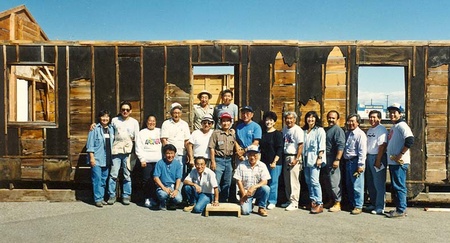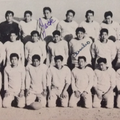Upstairs in the Japanese American National Museum is a barrack from Heart Mountain Relocation Center. For visitors, the barrack has come to feel like the heart of the museum, a tangible reminder of the unconstitutional incarceration of over 120,000 Japanese Americans during WWII in America’s own concentration camps.

The barrack currently kept in the Common Ground exhibition, reassembled in Los Angeles in 1994. (Photo courtesy of the Japanese American National Museum)
The story of how the barrack came to the museum began more than fifteen years ago, around the time when staff members began discussing plans to relocate the museum’s collection to a new building. Early supporters of the idea, including staff member Nancy Araki and graphic designer and former Heart Mountain inmate John Miyauchi, envisioned the barrack as a powerful way to tell the story of the Japanese Americans incarcerated during the war. Without a new building to house it, the barrack remained a sketch in Miyauchi’s conceptual plans.
Then in 1994, things began to come together when Araki crossed paths with Bacon Sakatani. Sakatani, upon seeing Miyauchi’s sketch, told Araki that he knew where to find a barrack for the museum’s collection.
After the war, the United States government sold the barracks used in the Japanese American concentration camps to homesteaders, giving them suggestions on how to reuse them as homes, barns, and sheds. Sakatani, incarcerated with his family at Heart Mountain as a young teenager, found several of these converted barracks during his first trip back to Wyoming in 1984 and, hoping to find a way to preserve them, returned to study them ten times in the next several years.

Volunteers disassemble the barrack piece by piece, under the direction of preservation architect Jim McElwain. (Photo courtesy of Bacon Sakatani)
Realizing that they shared a dream, Sakatani and Araki, along with a growing team including preservation architect Jim McElwain and contractor David Honda, began planning their own trip back to Wyoming to retrieve two of the barracks. Despite challenges presented by a limited budget, those who lent their knowledge and time to the moving of the barracks shared a common belief in the importance of preserving such a crucial piece of history. Some traveled more than 1,000 miles at their own expense in order to be a part of the project.
“Things just really came together,” says Sharon Yamato, who came to Heart Mountain with her cousins both to help and also to write a piece about the project for the Los Angeles Times. Born after the war ended, Yamato never lived in a barrack, but her parents and seven of her siblings were imprisoned at Poston and their experience moved her to help tell their story.

Sharon Yamato (center) and other volunteers eat lunch together on the project site. (Photo Courtesy of Sharon Yamato)
After her article for the Los Angeles Times, Yamato went on to write further about the preservation of the barracks in Moving Walls, a heartfelt book combining her words with fellow volunteer Stan Honda’s striking black and white photographs.
The book is a representation of the effect the preservation project had on volunteers and visitors to the exhibition alike. By the 1990s, those who were adults during the incarceration had largely passed away, often before sharing stories of their camp years with their families. For the former inmates who were still alive, being able to see the barrack as a familiar symbol of what they went through sparked memories often long pushed aside. And for Sansei whose parents never talked much about the war years, the sight of a barrack behind a chain-link fence provided a powerful catharsis, a way of connecting to a piece of their family history.

Staff and volunteers pose in front of the barrack after its successful reassembly in Los Angeles. (Photo courtesy of Sharon Yamato)
This Saturday, August 7, participants will reunite to speak about the 1994 relocation of the Heart Mountain barracks. Sakatani, Araki, Yamato, McElwain, and David Honda will all be present, and the program will include a screening of Mark Mohr’s award-winning 1994 documentary “Legacy of the Barracks.” Sharon Yamato’s book, Moving Walls, will be available for purchase at the Museum Store.
© 2010 Mia Nakaji Monnier





